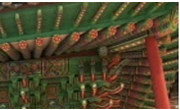Flame resistant treatment has been applied since 1973 for fire prevention in historical wooden buildings, but several problems, such as whitening and discoloration are constantly occurring in some Dancheong, in spite of evaluation criteria. It is supp...
http://chineseinput.net/에서 pinyin(병음)방식으로 중국어를 변환할 수 있습니다.
변환된 중국어를 복사하여 사용하시면 됩니다.
- 中文 을 입력하시려면 zhongwen을 입력하시고 space를누르시면됩니다.
- 北京 을 입력하시려면 beijing을 입력하시고 space를 누르시면 됩니다.

목조문화재 단청에 방염제가 미치는 영향평가 = Impact Assessment of Flame Retardant on Wooden Building with Dancheong
한글로보기https://www.riss.kr/link?id=A101956684
- 저자
- 발행기관
- 학술지명
- 권호사항
-
발행연도
2016
-
작성언어
Korean
-
주제어
방염제 ; 목조문화재 ; 백화물질 ; 단청 ; 보존 ; Flame Retardant ; Historical Wooden Building ; Whitening crystal ; Dancheong ; Conservation
-
KDC
900
-
등재정보
KCI등재
-
자료형태
학술저널
-
수록면
56-69(14쪽)
-
KCI 피인용횟수
1
- DOI식별코드
- 제공처
- 소장기관
-
0
상세조회 -
0
다운로드
부가정보
다국어 초록 (Multilingual Abstract)
Flame resistant treatment has been applied since 1973 for fire prevention in historical wooden buildings, but several problems, such as whitening and discoloration are constantly occurring in some Dancheong, in spite of evaluation criteria. It is supposed that these phenomena are caused by the stability issue of flame retardant, Dancheong production methods, the residue of chemicals, which were applied in the past, building location environments, etc., but no evaluation and cause inspection has been performed. Therefore, this study aims to verify the effect of flame retardant on Dancheong by producing Pseudo-samples and setting spatial and temporal environment conditions. Pseudo-samples of Dancheong were produced using three methods; the method specified in the Standard Specification of Properties; the method, which is generally used in the site and the traditional method. For different environment conditions of pseudo-samples, the areas were classified into a coastal area and an inland area and the places were classified into a sunny place and a wetland. After applying a flame retardant, annual variations were inspected for 12 months and change aspects were observed through scan and regular observation. In annual variation inspection, various variations like whitening, decolorization, dissolution and exfoliation were found and especially, whitening was most dominant. When the effect of flame retardant depending on the production methods was analyzed, whitening occurred in all the three production methods. It is supposed that this is because calcium(Ca) was contained in the coloring material of each production method and it reacted with phosphorous(P) of flame retardant. When the effect of flame retardant depending on the environment conditions was analyzed, whitening occurred more in the coastal area than in the inland area and it reduced in the building in a sunny place, which was constructed using the traditional method. It is supposed that this results from the humidity change and the difference of glue used in each production method. In conclusion, for using a flame retardant containing phosphorous(P), there is a need to check if calcium components including Oyster Shell White were used in Dancheong in advanc
국문 초록 (Abstract)
우리나라는 목조문화재의 화재예방을 위해 1973년부터 현재까지 방염처리가 실시되고 있으나, 검정기준이 제시되었음에도 일부단청에서 백화현상 및 변색 등의 문제가 지속적으로 발생되고...
우리나라는 목조문화재의 화재예방을 위해 1973년부터 현재까지 방염처리가 실시되고 있으나, 검정기준이 제시되었음에도 일부단청에서 백화현상 및 변색 등의 문제가 지속적으로 발생되고 있다. 이러한 현상의 원인은 방염제 약제의 안정성 문제, 단청 제작방법, 과거 도포되었던 약제의 잔류, 그리고 건물 입지환경 등으로 추정되고 있으나, 이에 대한 평가와 원인규명은 수행되지 않은 실정이다. 이에 본 연구에서는 의사시료 제작 및 공간적·시간적 환경조건을 설정하여 방염제가 단청에 미치는 영향을 규명하고자 하였다. 단청 의사시편 제작은 문화재수리표준시방서에 명시된 제작방법, 현장에서 일반적으로 통용되는 방법, 그리고 전통기법에 준하는방법의 세 가지로 제작방법에 차이를 두어 실시하였다. 의사시편은 환경조건의 차이를 위해 해안과 내륙으로 지역을 구분하고, 각 환경조건에 따라 양지와 습지로 장소를 나누어 설치하였다. 방염제 도포 후 12개월간 경년변화를 조사하였으며, 정밀촬영 및 주기적인 관찰을통해 변화양상을 파악하였다. 경년변화 조사결과 백화, 변색, 용해, 박락 등 다양한 변화가 발생되었으며, 그 중 백화현상이 가장 지배적인 것으로 나타났다. 제작방법별 영향 분석결과, 세 가지 제작방법에서 모두 백화현상 발생하였는데, 이는 각 제작방법의 채색재료에모두 칼슘(Ca)성분이 포함되어 있기 때문에 방염제의 인(P)계 성분과 반응하여 백화현상이 발생한 것으로 판단된다. 환경조건별영향 분석결과, 해안지역에서 내륙지역보다 백화 발생률이 높게 나타났고, 양지에서 전통 제작방법의 백화정도가 감소되었는데, 이러한 현상은 습도변화와 제작방법별 교착제의 차이에 의한 영향으로 판단된다. 결론적으로 인(P)계 성분이 포함된 방염제 사용시단청에 호분 등 칼슘성분이 사용되었는지의 여부를 우선 파악해야 하며, 그 외 단청 시공에 앞서서 장소 조건 및 단청 시공 조건 등에대한 다양한 사전조사가 이루어져야 한다.
참고문헌 (Reference)
1 "화재현황통계" 국민안전처 국가화재정보통계센터
2 최문순, "제2숭례문재발방지(방염제사업) 보고서" 2008
3 한규성, "목조문화재 화재예방 방염제 성능평가 및 도포기준 연구" 2013
4 한규성, "목조문화재 방염제 성능개선을 위한 기초연구" 2011
5 "기후자료" 기상청
6 정용재, "국내방염제 도포 실태 조사 및 현황분석" 2012
1 "화재현황통계" 국민안전처 국가화재정보통계센터
2 최문순, "제2숭례문재발방지(방염제사업) 보고서" 2008
3 한규성, "목조문화재 화재예방 방염제 성능평가 및 도포기준 연구" 2013
4 한규성, "목조문화재 방염제 성능개선을 위한 기초연구" 2011
5 "기후자료" 기상청
6 정용재, "국내방염제 도포 실태 조사 및 현황분석" 2012
동일학술지(권/호) 다른 논문
-
- 국립문화재연구원
- 황세옥
- 2016
- KCI등재
-
- 국립문화재연구원
- 이재완
- 2016
- KCI등재
-
『숙천제아도(宿踐諸衙圖)』를 통해 본 조선시대읍치(邑治)의 공간구조와 관아(官衙) 조경
- 국립문화재연구원
- 신상섭
- 2016
- KCI등재
-
부여(扶餘) 능산리고분군(陵山里古墳群) 성격(性格)에 대한 재고(再考)
- 국립문화재연구원
- 김규운
- 2016
- KCI등재
분석정보
인용정보 인용지수 설명보기
학술지 이력
| 연월일 | 이력구분 | 이력상세 | 등재구분 |
|---|---|---|---|
| 2027 | 평가예정 | 재인증평가 신청대상 (재인증) | |
| 2021-01-01 | 평가 | 등재학술지 유지 (재인증) |  |
| 2018-01-01 | 평가 | 등재학술지 유지 (등재유지) |  |
| 2015-01-01 | 평가 | 등재학술지 유지 (등재유지) |  |
| 2011-01-01 | 평가 | 등재학술지 선정 (등재후보2차) |  |
| 2010-01-01 | 평가 | 등재후보 1차 PASS (등재후보1차) |  |
| 2008-01-01 | 평가 | 등재후보학술지 선정 (신규평가) |  |
학술지 인용정보
| 기준연도 | WOS-KCI 통합IF(2년) | KCIF(2년) | KCIF(3년) |
|---|---|---|---|
| 2016 | 0.39 | 0.39 | 0.32 |
| KCIF(4년) | KCIF(5년) | 중심성지수(3년) | 즉시성지수 |
| 0.3 | 0.32 | 0.57 | 0.08 |




 RISS
RISS







